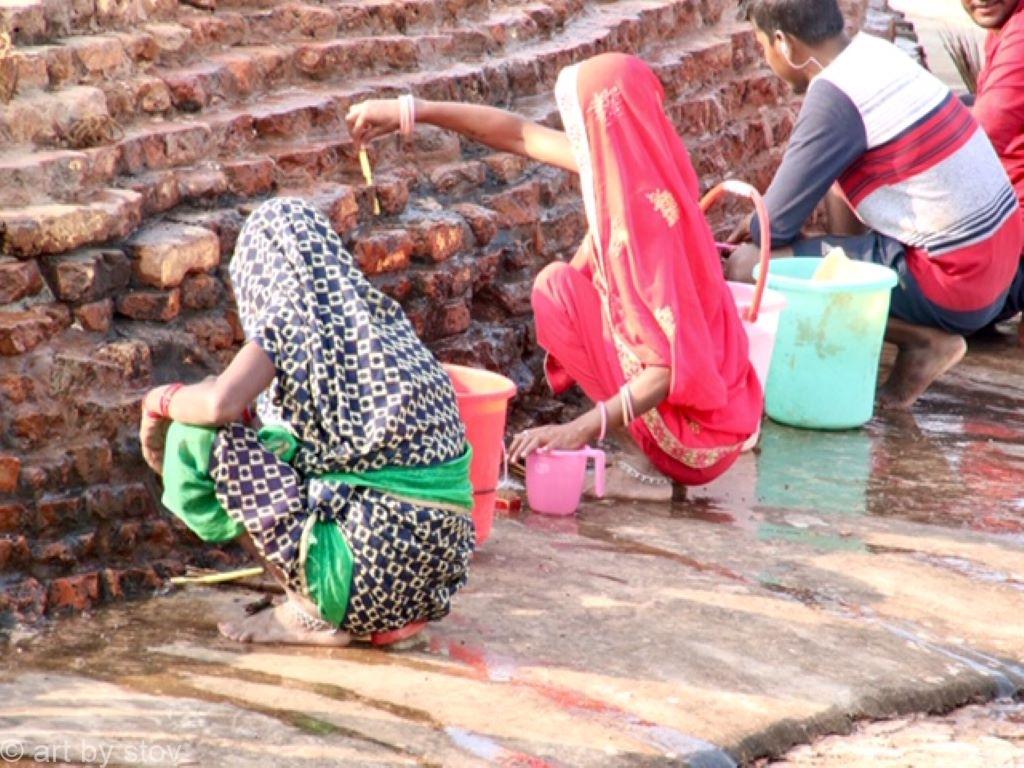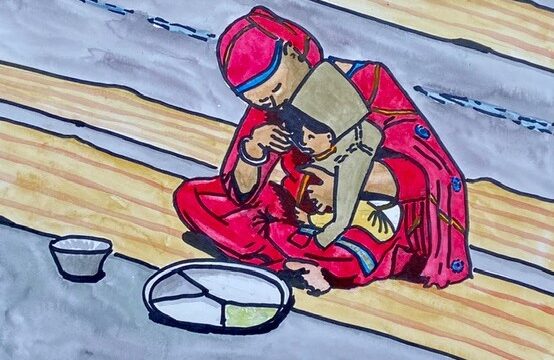
Blog 5. Amritsar – Making Langar Chapatis and Closing the Border
Day 3. Saturday 16th November – Amritsar
Woke up at 08:00! Blinking phone alarms……..
There is a waterway about a quarter of a mile from our hotel and I was hoping to get up early and see if I could spot a few birds there or in the orchards at the side of the road and at the back of the hotel (Did I mention i’m a bit of a birder?). No time for that now, instead, I viewed what appeared to be an inflated cow lying at the side of the Grand Trunk Road (GTR). Out with the binoculars, it was a dead bloated cow. I was relieved to see that it was not the all black, central reservation hogger from the previous day but still saddened as it lay there on its side legs stiff and straightened. I reminisced about the hippo we saw in a similar state in the game reserve at Nkasa Lupara in Namibia almost exactly a year before. The one that our guide Stefan tried reassuring us was not dead but laying down and basking in the sun! This cow was in the shade and as dead as the basking hippo.
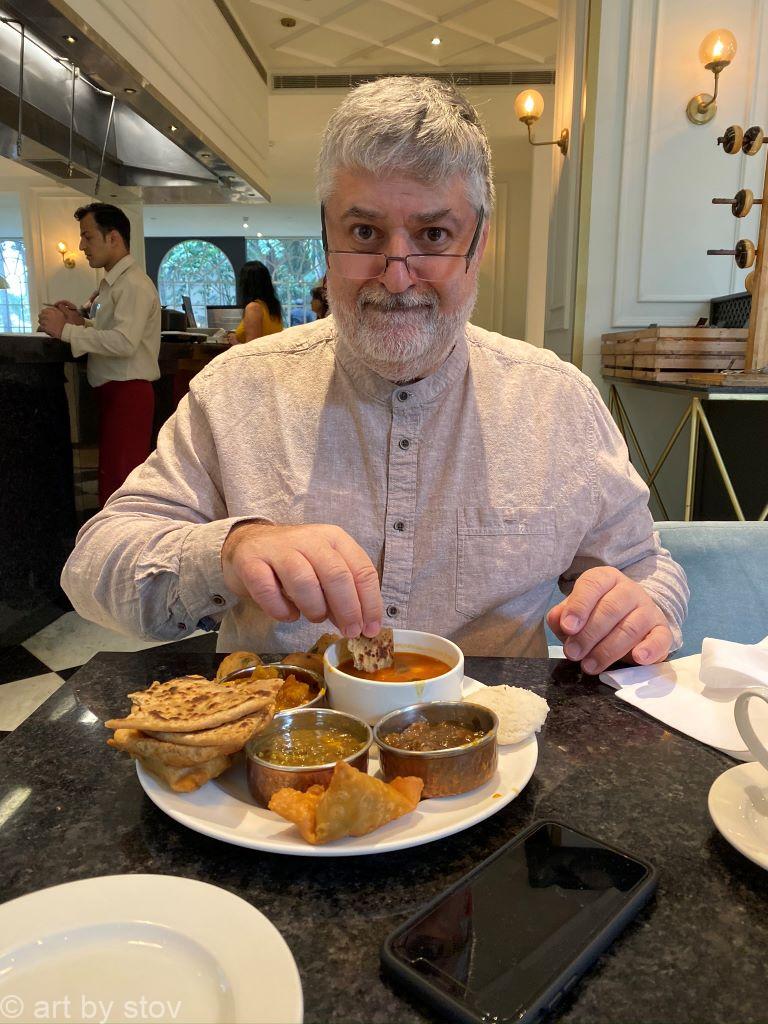
Washed, scrubbed and ready for the day ahead we went for another great breakfast. The Ever Lovely found the boiled eggs. I can’t remember what I ate but it would have been spicy. We decided on black tea, ordered two and received one. When I asked for a second black tea the waiter pointed at the tea we already had and was surprised when I said that I too wanted one. The Restaurant manager Rahul came over and arranged for tea number two to arrive. We also asked the manager about breakfast the next day as we had to leave at 05:30. he said that he would organise a picnic box, we agreed the contents and thought job done.
Our driver, Heera picked us up at 10:00 to head to Amritsar central. He told us “Anil will meet us there”.
Anil was in a good mood. He also called us foreigners. Following the conversation with the waitress the night before I decided there must be something behind this, so I asked. Apparently anyone who is clearly not an Indian is referred to a foreigner. This can also apply to NRIs (Non Resident Indians). Non resident Indians are persons who were born in India but who now live elsewhere in the world…as we know there is an ever growing diaspora. I explained to Anil that in the UK to use such a term is impolite, some may even consider it offensive. This amused him but he reassured me that in India it was a sign of respect. The ever lovely and I discussed this assurance later – we were not convinced.
We were off again to the Golden temple to see what goes on there during the day. Anil told us about the history of Sikhism, Amritsar and it’s holy places and and the clever muse by the tenth Guru who instead of naming a human successor named the holy book, the Granth Sahib, which is why it is now called the Guru Granth Sahib, a masterstroke. It was the Guru we had watched being put to bed the night before.
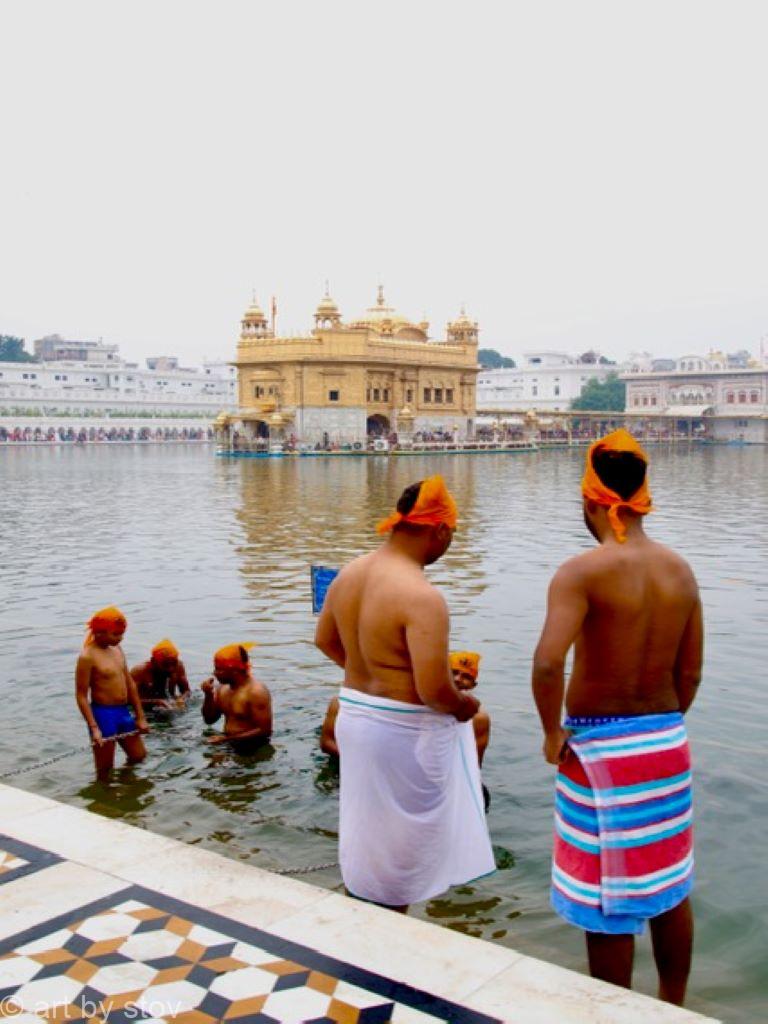
Again, all the little details are attended to. An army of volunteers make sure the temple remains clean and that all visitors are shown the legendary hospitality. Right from those outside who took our shoes in exchange for a token to return them later, to the man who had the job of ever so gently skimming the algae from the surface of the Amrita Saras (“Pool of Nectar”), or pool in the centre of the temple to keep the water clear. I was amazed to see fish in the pool, not there for any religious purpose apparently but also to help keep the water clear. The whole was most serene despite large throngs of the faithful and many tourists.
There were several trees of significance around the perimeter of the pool. One was planted where the first reader sat and read the holy book whilst they built the temple complex that we see today. The tree ordinarily has a 100 year lifespan outside the temple, this one was approaching 300 years old and still going strong, though supported by a massive steel frame to hold up the larger and more spreading branches. Another tree was directly opposite the end of the temple and holds particular holiness, though I quite forget why. It is here, directly opposite the temple building itself that the men dip themselves in the water to cleanse their souls and minds. Women too dip nearby in the privacy of their own enclosed “ghat”. We three passed this spot in silent reverence.
Further round was a tomb for Guru Gobind Singh, a hero who saved the Temple from destruction by the Mughals. The Sikhs are known as a warrior class, something that the British recognised in recruiting Sikhs as the back-bone of the premier regiments of the Raj army. The warrior Sikhs or Nihang which literally means “the immortals” wear indigo blue robes and yellow turbans. We saw two, quite striking, bare foot and holding their spears. They seemed larger than life, barefoot and tall there at the side of the pool.
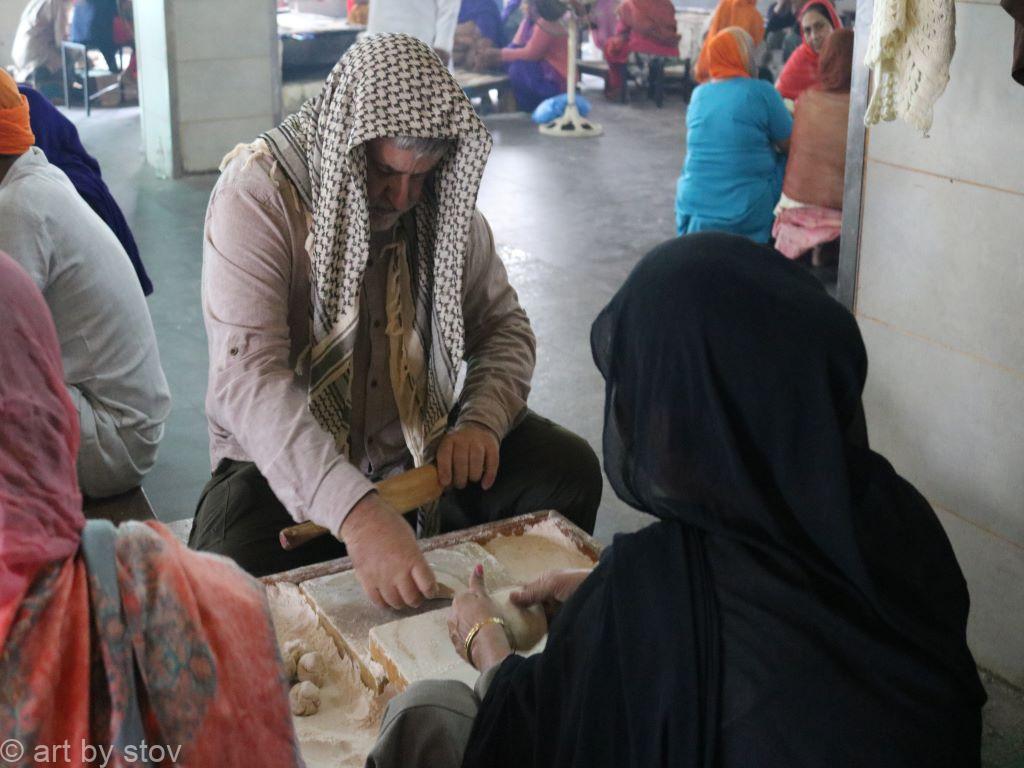
Just outside the temple walls lies the Langar hall and kitchens. Here a combined staff of hired cooks and volunteer helpers prepare food for over 100,000 people per day. Dahl, Chapatis (a flat unleavened bread) and Rice pudding for anyone who wishes to sit and eat. It is a massive feat of organisation and anyone can chip in at any time. You do not need to pay nor are any questions asked about eligibility the food is available to all comers.
I helped by collecting a basket of Chapatis from the mechanised “Chapati Queen” and delivering them to the table where a host of volunteer women brushed them with ghee (purified butter) ready to be shipped off to the holding area outside each of the two eating halls. I also had a go at making chapatis by hand and was praised by my mentor, who said to the ever lovely that she must be happy now that her husband can cook! My fellow chapattis makers were surprised that I did all the cooking at home. I felt like the Chapatti King!
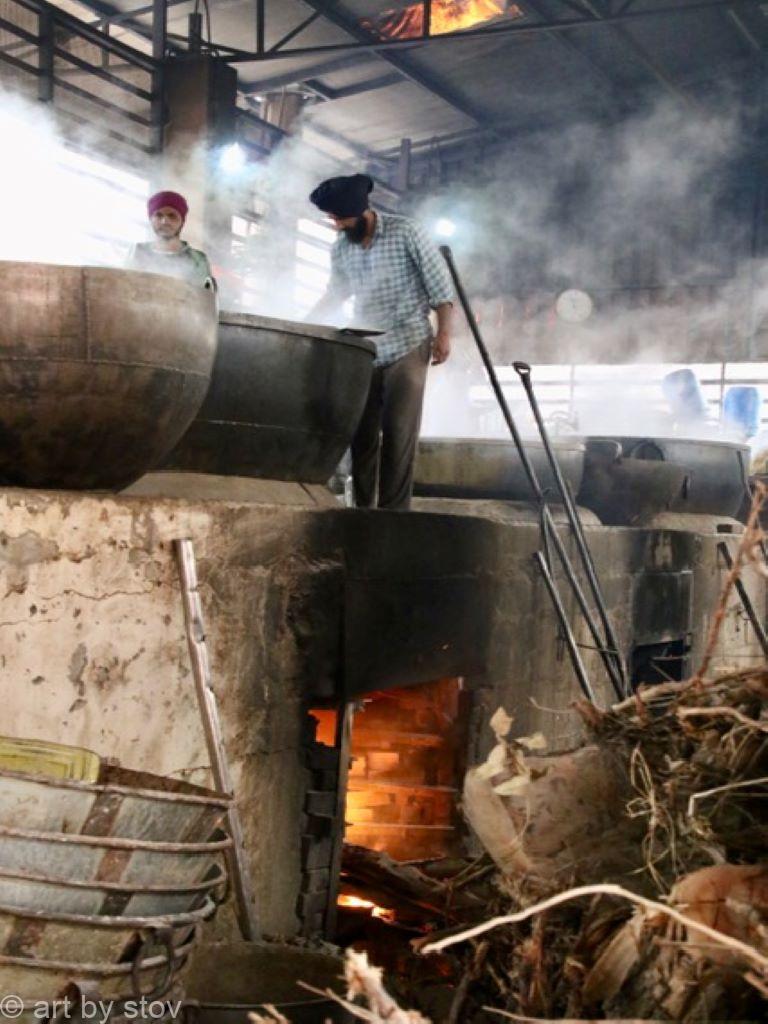
Due to the continued growth of the Langar it was interesting to see the semi automated newer side of the operation contrasted with the hand driven traditional method. The Chapati Queen is a prime example. Raw dough goes into a hopper, which cuts it into small, equal lumps, rolled flat, and passed by a conveyor belt over gas flames. The cooked breads eventually tumble into a large basket. The “new” side cooked on gas, whereas in the “old” kitchen the chapatis dahl and rice pudding were cooked over wood fires. It is dangerous work, three years ago one of the paid cooks fell into the Dahl whilst it was cooking; he died of his injuries three days later. Only the paid chefs are allowed to cook the rice and dahl now. The chapatis are cooked by volunteers whose dexterity at flipping the floppy new breads onto the hot plate, turning them and flipping them off into another basket is quite spell bounding.
Before we entered the Langar halls themselves we were introduced to the team at the entrance. Here, vast pots of dahl and rice pudding were brought from the kitchen and decanted into large, handled mini vats holding about 25 kilograms each. In two enormous cupboards the chapatis were kept warm, including at some stage my very own creations. Armed with ladles the volunteers went into the hall and dropped a goodly sized portion and two breads on the sectioned tin plate of each of the waiting hungry who sat in long lines across the hall. It reminded me of a seated terracotta army but dressed in bright Indian clothes. Just like the soldiers these peaceful souls were true individuals, some tourists but many many faithful who have traveled from afar to worship at the most holy site of the sikh religion.
Up to this point apart from a few Common Mynahs I hadn’t seen any birds in Amritsar itself. I was amazed that in the temple compound there were a plethora. Rose Ringed Parakeets and common pigeons nesting in the holes in the towers and swooped from one to another. Black Drongos, Red Vented Bulbuls and yet more parakeets were on the wires between the two “votive” poles. My heart rose when I saw my first Black Kite of the holiday circling the entrance tower. The birds obviously appreciated the sacred vibe which surrounded the whole golden temple complex. I hadn’t believed it when the ever lovely and her mother had described it as a truly a spiritual experience after their visit in 2016. I was now in harmony with this description.
We were sad to leave the temple, paddled through the foot bath and back to pick up our shoes. Whilst waiting for Anil to return with our reclaimed footwear I was captivated by a small child playing with the gold bracelet around it’s mother’s ankle… an expensive looking toy but offering plenty of amusement to this young Indian. We felt at peace with the world.
Next we headed for the Jalianwala Bagh, the site of one of the worst atrocities inflicted by the British on their subcontinental subjects during the Raj. I have read much over the years surrounding the history of this event which Winston Churchill described as ‘an extraordinary event, a monstrous event, an event which stands in singular and sinister isolation’.
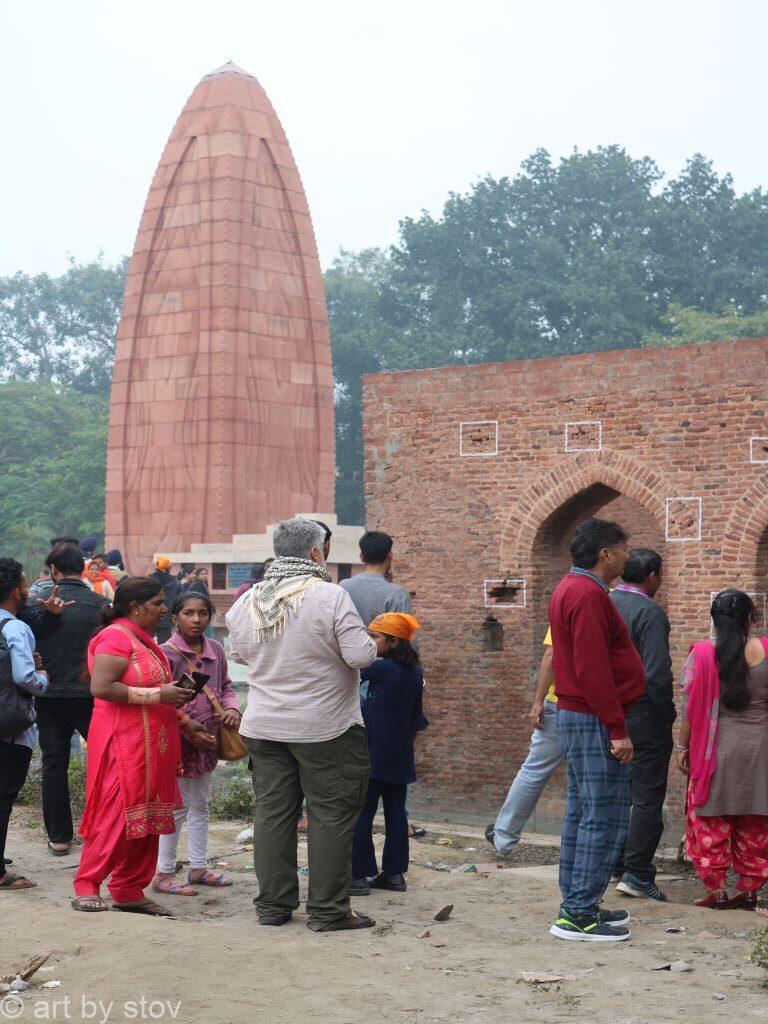
Let me take you back to 1919, it was harvest time and Amritsar was packed full of farmers coming to celebrate a good year’s crop at the Vaisakhi festival and to negotiate a good price for their produce. A large unarmed, peaceful and joyous crowd gathered in the Jallianwala Bagh, an open space between houses, not even a park or garden, just a plain ordinary open space. There was only one very narrow entrance and exit. When the ever lovely and I walked through the alley into the Bagh I could touch each side with my arms spread. Brigadier Reginald Dyer ordered his 50 Indian sepoy troops to spread out along the wall either side of the entrance.
I have to thank my mum for my sensitivity to the spirit world, which I have to say has been pretty much absent for a few years now but which now returned with a vengeance. I could feel the hurt and suffering and felt bloody angry and ashamed at what we Brits had done to India. Anil surprised me by saying that the British did much good for India principally by bringing so many disparate groups together into one country. He was not the last Indian on this trip to hold this opinion. I was left considering his comments in light of my learned “truths”, our Divide and Rule approach, the famines we caused and failed to relieve, the manufacturing and trade that we destroyed. Not to mention the intentional destruction of the education system and reintroduction of the caste system. In every facet of life the British had created an inferior class of citizen, the Indians with ever lower standards of achievement. It was my understanding that Sardar Patel had united India by negotiating with the 650 plus princely states to join the Republic of India and thus avoiding an all India civil war. Gosh, would I like to have a long conversation with a true Indian over these issues. Perhaps one of those dinners where you could invite a variety of guests, alive or deceased, to dine and share opinions and ideas.
My experience in this truly moving and disturbing place would, I am sure, have been even greater had they not been renovating large parts of the open space. If the view of the whole area had been possible I don’t think I could have coped.
As we left the ever lovely reminded me that we needed to hit an ATM. We were guided by Anil to a dusty old door behind which was the most heavily disguised ATM. The keys were all worn out but thankfully, pressing bottom right the screen sprang to life and prompted us to select a language. The instructions in English were pretty easy to read and follow.
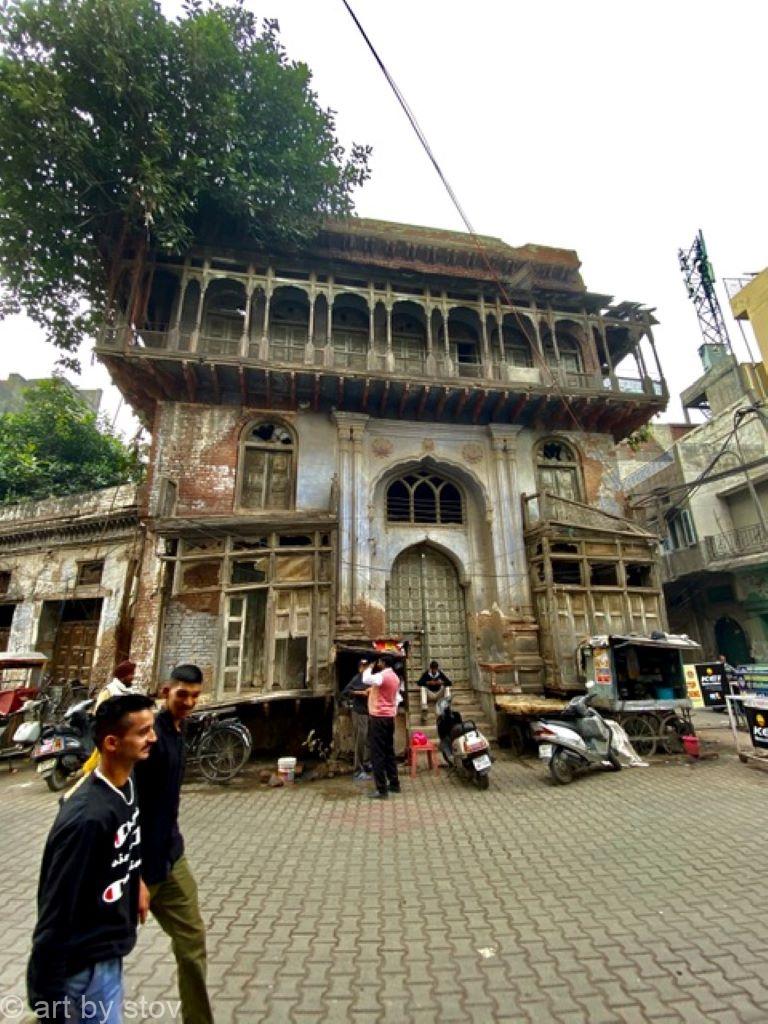
As we turned and walked out we were faced by a most incredible ruined haveli across the road. I had taken some photos of the side as we walked up the street but now seeing it from this angle showed how truly imposing this palace had been. It made us sad that such beauty was just rotting into the dust.
Back where the car was parked we met Heera and said goodbye to Anil. We thanked him for the fantastic experiences he had given us. He explained that Heera would drive us to get some food either back at the hotel or at a selected restaurant. We decided to go back to the hotel to freshen up. The ever lovely wanted to wash her feet …she was almost apoplexic at having to walk around the kitchens and through the spilled food at the Langar barefoot! Oh and we also fancied another lamb kalkhi and focaccia. This time without the cinnamon donut.
A quick turn round and off with Heera at 14:;15 to the Wagah border post. Still no idea of who we pay for it or how but hey…….it’ll all come out in the wash. (It never did).
Down the GTR into and through central Amritsar. As we passed over the railway line there was a train coming into the station. Bundles of goods were being thrown out of virtually all the doors we could see. I saw this on a TV programme. The bundles being ejected were the trading goods of people who do not wish to pay the railway for carriage. As they approach their final destination they jettison the goods. After alighting at the station they rush back up the track and collect their packages. Life in action I thought to myself.
Out into the country with the ever lovely trapping flies….but not snoring! I think I may join her. I didn’t, being captivated by the thirteen weddings we passed, pink is obviously this year’s colour. Then I noticed tanks and guns at the entrance to barbed wire compounds on the left. Heera told me that this was the headquarters of the Border Security Force (BSF) and on the other side was a large army base. The vehicles at the entrance to the two bases were incredible, like a history book of British armaments from the 40s, 50s and 60s. The BSF exists to protect the boundaries between India, Pakistan and Bangladesh. Until 1971 Bangladesh formed the eastern portion of the two part Pakistan. The BSF is the largest border security force in the world at over a quarter of a million strong.
Armament spotting over at last I nodded off and joined the ever lovely trapping my own flies.
I woke up as we slowed at the security gate at the border. It is a massive operation, over 30,000 India fanatics fit in the new stadium that they have completed since the ever lovely and her mum were there in 2016. Under instruction from Heera to exit our seats as soon as the flag had been lowered we joined the throng and into the “foreigners” section of the auditorium. This was low down on the right hand side almost on top of the gate. In front of us and to the left the Indian crowd massed to celebrate their country.
For pure entertainment the crossing closure ceremony was top value. An army officer whipped up the crowd as good as any warm up act at the London Palladium. On the Indian side the big hit from the Slumdog Millionaire film, Jai Ho! rang out (a number of times actually). Dancing broke out like an epidemic. Interspersed with other up tempo hits were choruses of the rousing chant Hindustan Zindabad (Long Live India), pushed through a massive PA system. The crowd was urged on by the warm up officer and reached new heights of frenzy. Oh, I really gave it some Jai Ho and Hindustan Zindabad, belting it out as I would Swing Low Sweet Chariot and Jerusalem at Twickenham. We were really getting into the swing and feeling quite elated, swept on by India’s finest. In contrast on the Pakistan side a quietly shuffling audience of two, maybe three thousand sat in silence as a lone voice recited verses from the Koran.
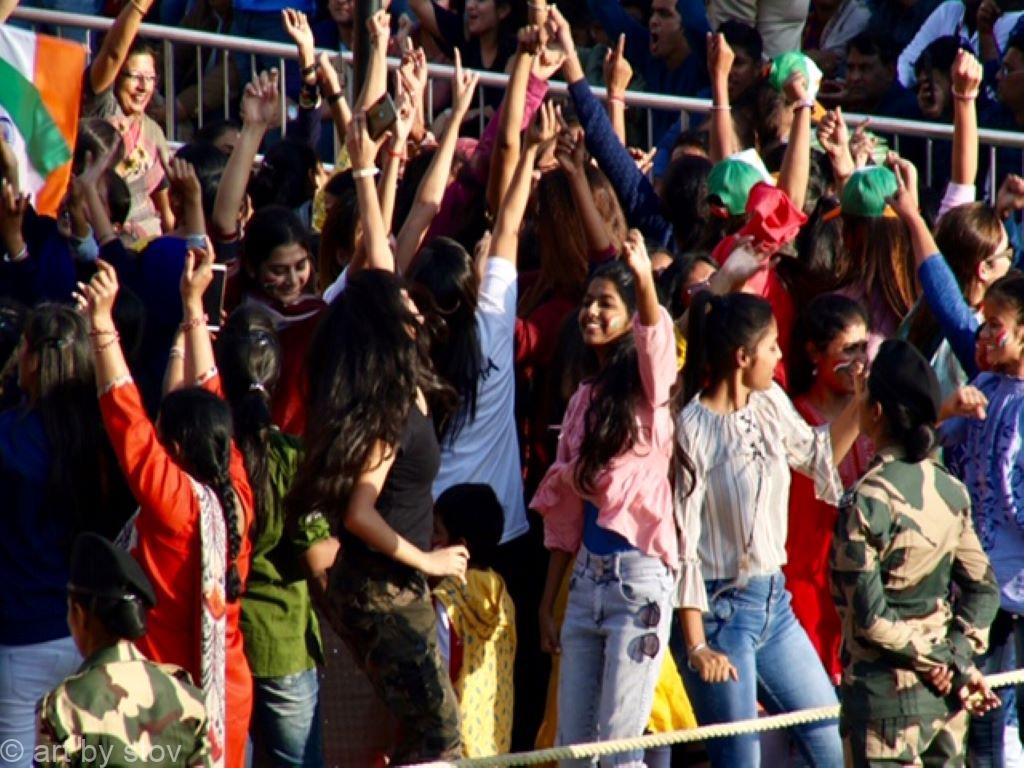
It has to be said that as India Incorporated hit a crescendo Pakistan raised it’s game with the introduction of two dhol drummers and a single, whirling dervish. The dancing was amazing and it was only when he hopped off at the end of his dance to pick up his crutch that I realised he only had one leg. There was a round of applause from the Indians celebrating this true paralympian!
Apart from the inability for Indian soldiers to effect synchronised marching the whole show was fantastic. I guess in the UK we are so used to seeing the guards regiments trooping the colour etc that we expect perfection.
Here is my step by step guide to how to close a border between two, oh so belligerent nations.
- Fill a stadium with 30,000 people.
- Play loud music, dance and wave a lot of flags
- Pass around a giant flag (crowd-surfing style)
- Set your special security forces, seriously frightening men, at each side of the border gate*
- Let a random family of four plus large, tatty suitcases cross from Pakistan into India
- March up and down in a very silly style
- Have one of your men march up to an equally silly Pakistani soldier and shake his hand in a very hammy way
- Have one of your soldiers march to within twenty feet of the border and front off (chest puff and arm wave) at one from Pakistan who does the same
- Have two of your soldiers march to within twenty feet of the border and front off (chest puff and arm wave) at the two from Pakistan who do the same
- Let the national flag down in synch with your Pakistani oppo
- Have your flag marched off at speed up the road toward Amritsar
- Pull gate shut.
PS No need to ask the last one out to switch off the lights as the sun was already setting.
* The motto of the BSF is Duty Unto Death – looking at the special forces guys I had no doubt they mean every word of it.
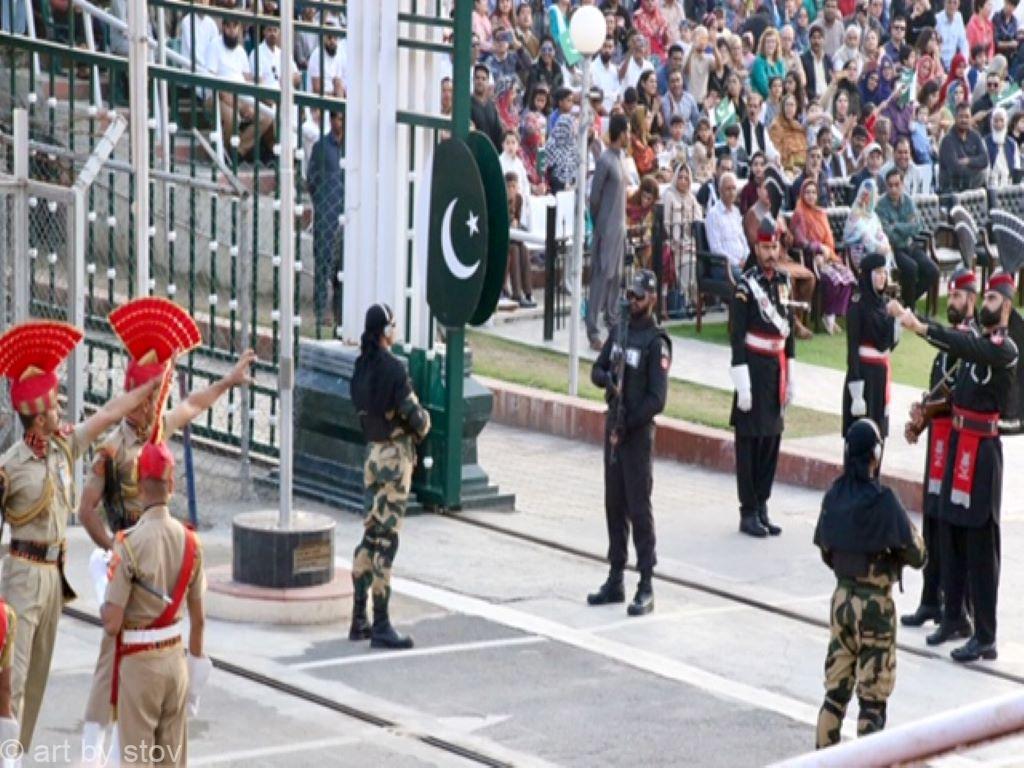
At point 9 we tried to follow Heera’s request and leave our seats. We were very firmly put in our place by a woman soldier. We tried again at point 10 with the same result. At point 11 we rushed the army and made headlong for our waiting driver. We walked skipped at breakneck speed to the car park, into the car and then Heera barged his way out of the car park and off to Amritsar. Driving through the city was manic…it was rush hour Saturday. Cars, auto rickshaws, buses, bikes, cows and even pedestrians in the main road regardless of each other.
Back at the hotel we enjoyed some restful time. I downloaded some photos and the ever lovely wrote up her log.
Down to dinner at 20:00. No sign of my adoptive Indian waitress so we had Manhas from Jammu & Kashmir. He wasn’t very good and kept fishing for compliments which made it even worse. He told us he works 06:45 to 22:00 every day of every week, yes that is 7 days per week. He is allowed to have time off once every three months but not enough to get back home.
I ate predictably the same as last night and it was not as hot as before. The Chef came out and introduced himself and explained that he tones down the heat for Foreigners because he knows they can’t take the real heat. I said that I would have preferred he asked me if I had timid taste buds. He then seemed to be disappointed at my disappointment at his attempt to make me comfortable. I checked with the duty manager about our breakfast box (mentioned earlier in this blog)…just as well, they knew nothing about it. We told them again what we would like.
We went back to the room to pack for a 05:00 pick up. In bed by 01:00 with the alarm set for 04:00.
Join me next week as we get closer to the Buddha and take to the Ganges for a celebration of the River God
Missed an earlier Blog? Read about it here
